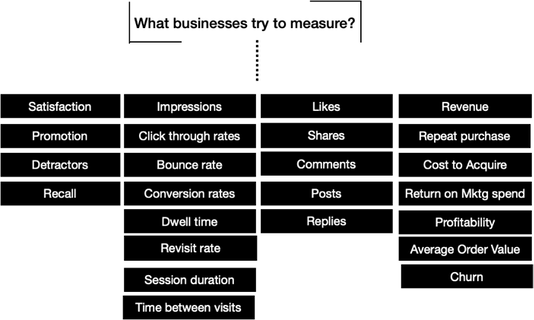Measure this to create experiences for long term customer loyalty
The loopy and fast world of customer journeys
Customers can be gained or lost in the blink of an eye

From what motivates a customer (trigger) to the actual purchase: your customers are in a continuous loop of exploring and narrowing down their options for products and services.
This loop of exploration and decision making is heavily influenced by what we are exposed to in our environment, the messages that we take in and our beliefs and motivations.
In addition, it is also heavily influenced by our past experiences with a brand or product.
In this Exploration and Evaluation loop, we are consciously or subconsciously influenced by the following factors.
Conscious and subconscious factors
Our Motivation
What is the problem that we are trying to solve? What utility would we expect from the product and service category? This is our broader expectation from a brand or product.
Our Context
What is going on around us? The time of day? Are we at home? Are we cooking? Are we focused? Are we distracted? What device are we using?
Intent
Intent is specific to the point of interaction. So when we complain, we want our issues to be resolved.When we have a clarifying question, we want our enquiry to be answered, When we purchase, we want an honest, convenient experience.
Our preferences
Product or services that we prefer.
Expectation fulfillment
Did the brand or the product fulfill our customer expectation
Expectation Fulfillment: What customers expect
Our written or un-written evaluation criteria
| I want my products to be delivered in a timely manner | I want the business to put themselves in my shoes (Empathy in CX) | I want the product to work as expected | I want personalized and curated offers that match my preferences | |
|---|---|---|---|---|
| I want an easy process to return the product if I am not happy | I want the business to respond to me in a timely manner | I don’t want a defective product | Please answer questions that I might have about your product or service | |
| I expect warranty/guarantee on products and services | I want the business to meet the intent and objective of my interaction | I want the product to delight me with every interaction | I want you to respect my privacy | |
| I information on your products and services on my own terms | I want the business to resolve my complaints and issues in a timely manner | I want you to recommend products that I might be interested in. | I want proof from others that I can trust. I want to know what others think of your products and services. |
What businesses try to measure
What our customers can do for us, and not what we can do for them

Although, these metrics are important and should be monitored, measured and predicted. They miss an important dimension. These metrics are focused on what customers can do for the business "what can you do for us". Will they promote, be a detractor, click on a link, re-purchase, bounce from the page?
In other words, what is needed is a complete measurement system that starts with quantifying what customers expect, and how the brand meets or exceeds these expectations at various points of interaction in the customer journey.
This foundational layer should link to the traditional business metrics such as promoter score, detractors, satisfaction, dwell time, engagement rate, and subsequently to the hard cost and revenue metrics.
Customer Emotions: The Elephant in the room
We are all more emotional than we think
Behavioral psychologists describe the emotional size as an elephant. refer to our emotional brain as the elephant. A 5 ton influence that explicit and implicitly shapes our decisions.
There is ample body of research that validates that emotionally connected customers tend to recall the brand more when it comes to making buying decisions, advocate more for the brand and purchase more than customers who are not emotionally connected.
There is an interesting research called the negativity bias or the negativity effect which is the notion that even when of equal intensity, things of a more negative nature (e.g. unpleasant thoughts, emotions, or social interactions; harmful/ traumatic events) have a greater effect on one's psychological state and processes than neutral or positive things.
It also means that for brands to move customers from positive to negative would require more positive experiences than negative.
For more details on how Emotional analysis helps in improving revenue and satisfaction, download our E-Book below.
Xmata Xclusive on Emotional Customer analysis
Get the Xmata E-book that shows how Emotional understanding helps in Key Business Performance Indicators.
The need for a total customer measurement system
Start with what customers expect and want from us
What is needed is a complete measurement system that starts with quantifying what customers expect, and how the brand meets or exceeds these expectations.
This measurement system must be underpinned by the emotional perceptions of our customers towards these product and service attributes.
This foundational layer should link to the traditional business metrics such as promoter score, detractors, satisfaction, dwell time, engagement rate, and subsequently to the hard cost and revenue metrics.
Six steps to measuring & improving a customer
The Xmata approach to measuring customer expectations
1. Consolidate
Customer feedback across reviews, social mentions, surveys, support channels
2. Automatic categorization
Breakdown customer feedback into themes, attributes of your products and services.
3. Emotional Analysis
Summarize and highlight the customer sentiments and emotions for the product and service attributes
4. Always on Monitoring
Measure what customers care about, and their emotions. Monitor for trends in improvement or decline for what matters to customers.
5. Prioritize Actions
Take actions that improve customer expectation outcomes: the metrics that customers care about, and compare the before and after performance.
6. Measure post action results
Did customers expectation metrics improve as a result of the actions we took.
Introducing the Xmata Emotional and Natural Language Understanding platform
Dedicated to help businesses meet and exceed customer expectations.
We realized that for companies to build a platform that continuously measures customer expectations, breaks down product and service attributes, analyzes emotions and helps prioritize actions requires development, and data science expertise across multiple disciplines.
We launched Xmata to do the heavy lifting of building, while you focus on your customers.
Get started with Xmata Emotional AI today
Understand your customers and create experienced that meet and exceed their expectations.
